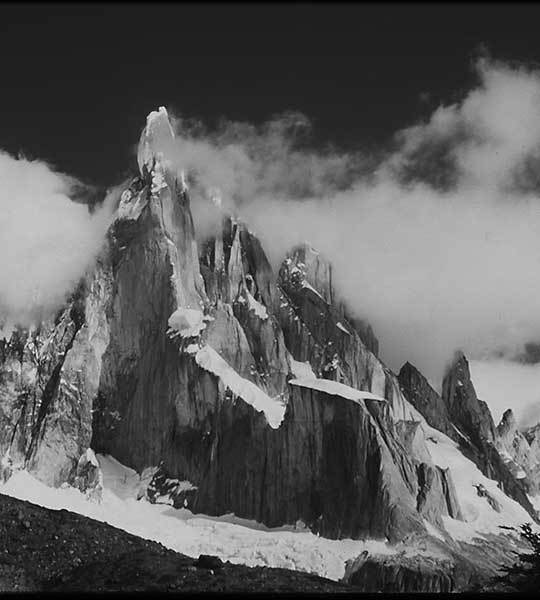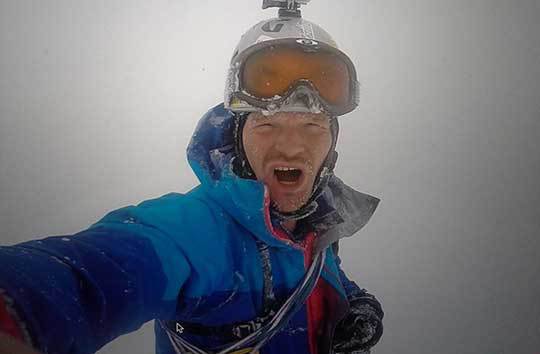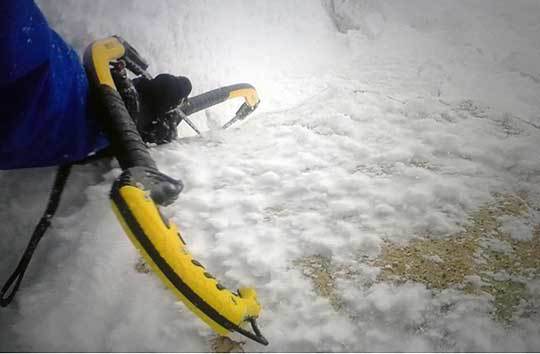
[This story was first published on pataclimb.com on December 29, 2014.–Ed.]
On December 27, Austrian alpinist Markus Pucher free soloed the Ragni route (M4 90 degrees, 600m) on the west face of Cerro Torre for the second time. He had free soloed this route back in early 2013, when he blazed up it in a mere 3:15. What was unique about his recent ascent is that it was carried out during a raging storm. No other ascent was done that day in the entire massif. Most climbers stayed safely inside the warmth of their hostels.
Markus started from Filo Rosso at around 6 a.m. There was much fresh snow on the way to the Col de la Esperanza so breaking trail was heavy work. The mountain was completely enshrouded in clouds, and therefore visibility was very limited. At the col, he stopped to have a cigarette and noticed two climbers below and to the right. They were on their way down, having judged the conditions too severe to continue. At the base of the Elmo formation he found a small cave that offered shelter. Here he smoked his second cigarette of the day. Smoking a cigarette from time to time, he says, gives him a sense of normalcy, bringing him back to the mundane and out of the wild energy that surrounded him.
Above, the mixed pitches were entirely snow covered, so it took much effort to find the way. He went too far to the left and had to negotiate some stiff M6 climbing. The headwall was also covered by a veil of snow, and the ice below was very hard, so as the ground got steeper and steeper he had to fight off a growing pump. Visibility was so poor and the terrain so severely snow covered that he failed to notice the end of the headwall and kept climbing up on the vertical ground to the right. After correcting his mistake, he tackled the first mushroom, where a vertical step led to a tunnel. At the end of the tunnel he found a sheltered alcove and had his third cigarette of the day.

Upon reaching the last pitch, he was unsure where to go. He tried to go straight up but desisted after five meters, realizing that the unconsolidated rime could give way any minute. His goggles were completely iced up, as were his gloves and his face. He could hardly see. He considered retreating but then decided that the unknown above held more sway than the certainties that lay below. By now he noticed that there was a half-pipe farther right, so he down climbed and traversed to it. The half-pipe led to the start of a tunnel. Here the wind picked up and ice crystals blew upwards, hitting his face and making it virtually impossible to see. The tunnel was too narrow for his wide chest, so he clenched his teeth tightly and pushed on, muscling his way upward. Now he was in full-on survival mode. He was in the wolf’s mouth, and the only way out was up.
It was 7 p.m. when he reached the summit. It had taken him seven hours from the plateau below the Col de la Esperanza. In the middle of a raging storm, the summit of Cerro Torre felt like the center of the universe. But the adventure had barely started. To descend he had only brought a 60m 7mm rope and three ice-screws. He knew he had to hurry because the night would be upon him soon. Of all the anchors that usually can be found on the route, he was only able to find two of them, so it took much creativity to get down.

He rappelled back to the Elmo and then continued down climbing slightly to the south. The ground got steeper, more vertical, and then suddenly his feet slipped and his ice axes started sliding. He fell in slow motion, hitting a sloping ledge after five meters, where he was flipped backwards. Now he was sliding headfirst toward the abyss. Here came what he described as his “Vertical Limit moment,” a reference to a notoriously dramatic Hollywood climbing film. He pressed the bottom of the axes firmly against the slope and, barely two meters from the edge of the 1300-meter-tall south face, he stopped.
Visibility was still very poor, and he was unsure where the Col de la Esperanza was. He down climbed too far to the north, finding himself again on vertical ground. When his feet hit rock below he realized he was in the wrong place. As he started climbing back up, another Vertical Limit moment happened, when the ice he was climbing cracked horizontally, barely below his axes. He says he owed his luck to the talisman that his daughter had given him.
Finally he found the Col de la Esperanza and continued down the easy ground below. By now it was completely dark. Half an hour later, his headlamp gave out. When his foot punched through a crevasse, he built a dead-man above it and dropped inside. Here he found a small cave that provided shelter. It was midnight. He had no stove, no water and no food. For his first 20 minutes he felt warm, but a deep, biting cold set in. He spent the following five hours punching the air, doing squats, jumping, doing anything he could to stay warm.
As soon as it was light outside, he carried on. Past the mixed climbing, he found himself on a steep snow slope that was loaded with a meter of fresh snow. An avalanche could take him any minute, but he had no option but to continue down.
He reached his camp at Filo Rosso at 7 a.m., after 25 hours on the go. This had been one of the most harrowing ascents in Patagonian climbing history. He made soup, and then decided that he had better get out of there. The 12-hour walk back to Chalten was peaceful and effortless. He had just lived the most intense experience of his life. Nothing was in the way anymore. He thought of his two daughters, reflected on past behavior and felt content, at peace. After 25 hours balancing on a knife-edge, here was a much richer man.
?
Postscript: Last week pataclimb.com published a long rant on risk management. This week they celebrate risk taking. They are well aware of the apparent contradiction this implies. They hope you can grasp the difference between one and the other. What you just read is an account of one of the most impressive ascents in Patagonia climbing history, carried out by one of the fittest and most capable men around. This is an alpinist in his prime, taking serious–albeit calculated–risks, fully aware of his predicament, even if at times not fully in control of the situation.